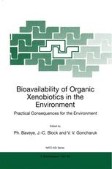Search
Search Results
-
Bioavailability and Biodegradation of Organic Pollutants — A Microbial Perspective
Environmental pollutants are a global issue due to direct contamination from growing industrialized centers, application of pesticides, herbicides...
-
Combined Biological and Abiological Degradation of Xenobiotic Compounds
In this chapter, we will discuss approaches to bioremediation of recalcitrant xenobiotic chemicals, specifically approaches that employ a combination...
-
Fungal Bioreactors: Applications to White-Rot Fungi
The growth mechanisms of filamentous fungi in liquid cultures ranges from dispersed mycelia to compact pellets. The excessive growth of mycelia gives...
-
The Effect of Interaction Between White-rot Fungi and Indigenous Microorganisms on Degradation of Polycyclic Aromatic Hydrocarbons in Soil
White-rot fungi applied for soil bioremediation have to compete with indigenous soil microorganisms. The effect of competition on both indigenous...
-
Screening of wood rotting fungi potentially useful for the degradation of organic pollutants
Many papers have shown that white rot fungi can degrade aromatic pollutants under laboratory conditions, but few report field scale trials. Here we...
-
Bioremediation of crude oil polluted soil by the white rot fungus, Pleurotus tuberregium (Fr.) Sing.
Bioremediation has become an attractive alternative to physicochemical methods of remediation of polluted sites. White rot fungi (WRF) are...
-
Source of Inorganic and Organic Nutrients and Interaction with Photons
Dissolved HS comprise incompletely oxidized carbon. Therefore, HS have the potential to act as substrates for oxidations. Thess processes can be...
-
Nutzung biotechnologischer Prinzipien bei komplexen Entsorgungs- und Sanierungsaufgaben
Holz ist ein Baumaterial mit herausragenden Eigenschaften und auch durch moderne Baumaterialien nicht zu ersetzen. Es besteht im Wesentlichen aus...
-
Lignocellulose biodegradation: Fundamentals and applications
Lignocelluloses are the building blocks of allplants and are ubiquitous to most regions ofour planet. Their chemical properties make it asubstrate of...
-
Biological remediation of explosives and related nitroaromatic compounds
Nitroaromatics form an important group of recalcitrant xenobiotics. Only few aromatic compounds, bearing one nitro group as a substituent of the...
-
Phytoremediation of polyaromatic hydrocarbons, anilines and phenols
Phytoremediation technologies based on the combined action of plants and the microbial communities that they support within the rhizosphere hold...
-
Aerobic and Anaerobic Biodegradation Potentials of Microorganisms
Microorganisms represent essential components of the global carbon cycle. In addition, it appears that most xenobiotic industrial chemicals can be...
-
Cellobiose dehydrogenase-dependent biodegradation of polyacrylate polymers by Phanerochaete chrysosporium
When Phanerochaete chrysosporium was cultured using conditions which promote the expression of cellobiose dehydrogenase (CDH), but not the...
-
Humification of PAH and TNT During Bioremediation — Evaluation of Long Term Risk and Sustainability
The depletion of contaminants in soil is not only based on degradation or mineralisation, but also on the fact that a fixation or immobilisation of...
-
Pulp Bleaching with White Rot Fungi and Their Enzymes
Lignin is one of the major components in plants. Selective removal of lignin from plant cell walls has significant implications on the pulp and paper...
-
Enzymatic Deinking
In recent years, the demand for the use of postconsumer paper products in the production of new paper products has risen dramatically. Some of this...
-
Decolorization and Detoxification of Bleached Kraft Effluents
The pulp and paper industry ranks third in terms of water consumption and fifth among the major industries in its contribution to water pollution...
-
Biopul**: a Less Polluting Alternative to CTMP
At present, pulp is produced from wood either by chemical delignification, mechanical separation of the fibers, or combinations of chemical and...
-
Organic Pollutants Associated with Macromolecular Soil Organic Matter and the Formation of Bound Residues
All anthropogenic organic chemicals form non-extractable residues to some extent after entering soils. This well known phenomenon has been studied...
